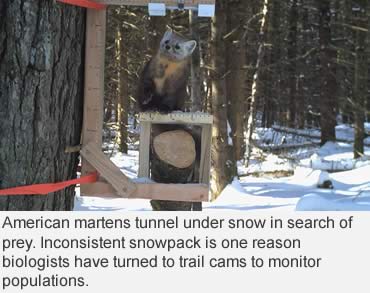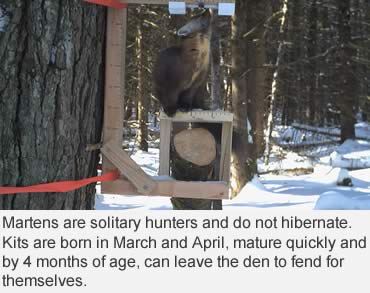Throughout the vast 1.5 million-acre Chequamegon-Nicolet National Forest in Wisconsin near Lake Superior, conservationist biologists are now using trail cam technology to search for the elusive American marten.
Early images reveal the biologists’ combination of bait and ingeniously placed yardsticks that measure and identify American martens will provide the help they need.
Modern trail cams are the new chapter for an old story. Unregulated trapping and habitat destruction led to the martens’ disappearance from Wisconsin by 1925. Various attempts were made to reintroduce the small predator in the 1950s.
Listed on the state’s endangered species list since 1972, martens are small brown, bushy-tailed members of the weasel family. American martens weigh between 1 and 3 pounds, and measure 1.2 to 2 feet in length. About a third of their length is in their long bushy tail.
 They are busy, busy, constantly-moving creatures that look like a cross between a house cat and a mink. In the previous century, martens were highly prized for their luxurious fur and trapped into near extinction.
They are busy, busy, constantly-moving creatures that look like a cross between a house cat and a mink. In the previous century, martens were highly prized for their luxurious fur and trapped into near extinction.
Since 1953, when Wisconsin returned 172 martens to areas that lacked martens or had small breeding populations in the Chequamegon-Nicolet National Forest, one question has gone unanswered.
How many of these evasive creatures remain?
That’s just one question conservationists in Wisconsin asked when they first sought to restore the American marten population. With modern trail cam technology, that answer is being formulated now. But researchers have many other questions.
Trail cams are now deployed at 120 different sites. Each camera is pointed at the specially-built platform, mounted on a tree in front of a camera. By encouraging martens to reach for a bait, it exposes the unique yellowish-orange fur pattern of the individual animal’s throat and chest.
 Biologists want to use the trail cam recorded images and data to track individual martens across multiple years, so they can generate a reliable estimate of populations size and annual survival. They also hope the images will reveal more about the American marten’s habits to help refine strategies for recovering the species.
Biologists want to use the trail cam recorded images and data to track individual martens across multiple years, so they can generate a reliable estimate of populations size and annual survival. They also hope the images will reveal more about the American marten’s habits to help refine strategies for recovering the species.
“We’re optimistic about the population status of martens in Wisconsin,” according to Skyler Vold, the conservation biologist leading the project for the Wisconsin Department of Natural Resources Natural Heritage Conservation Program. “Establishing long-term research and monitoring trail cameras may help us discover more details to aid marten recovery in the state.”
 Carly Lapin, DNR conservation biologist who is also working on the project, agrees. “American martens are an important species in Wisconsin,” she said, “because they are known as an ‘umbrella species.’ Managing Wisconsin forests to improve habitat for American martens will also improve habitat for a wide variety of other species that also rely on older forests.”
Carly Lapin, DNR conservation biologist who is also working on the project, agrees. “American martens are an important species in Wisconsin,” she said, “because they are known as an ‘umbrella species.’ Managing Wisconsin forests to improve habitat for American martens will also improve habitat for a wide variety of other species that also rely on older forests.”
Vold noted that “using cameras to collect these types of data is cheaper, requires less time in the field, and is less invasive to the study animals. Trail cameras will be a more reliable survey method than snow track surveys which have not been consistent in recent years in northern Wisconsin.”
The lower snow depths may affect martens’ efficiency in hunting prey in winter and their ability to out-compete with fishers, a successfully reintroduced member of the weasel family.
Expectations are positive for the trail cam project that began in December 2018.
–Resources: Wisconsin Department of Natural Resources National Heritage Conservation Program; Chance Finegan, The American Marten, National Parks Traveler.
–All photos courtesy Wisconsin DNR.